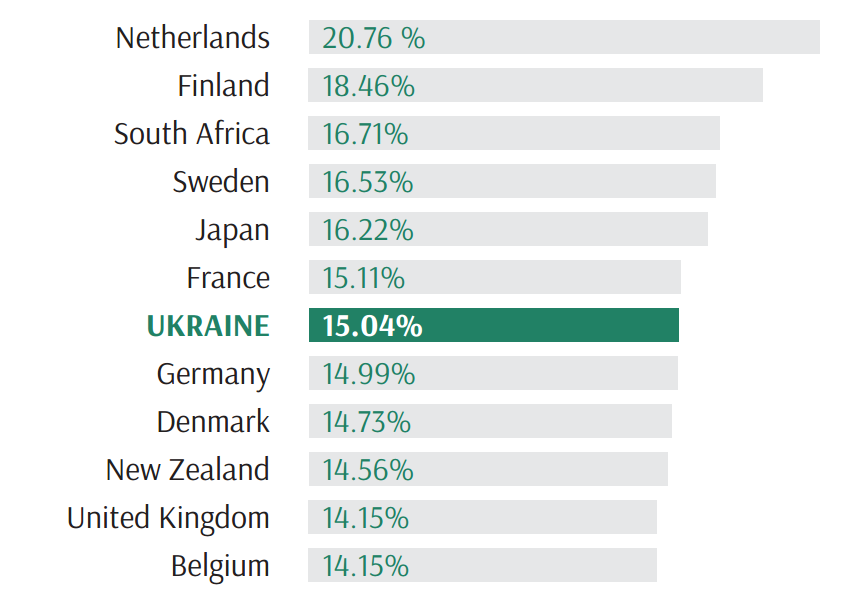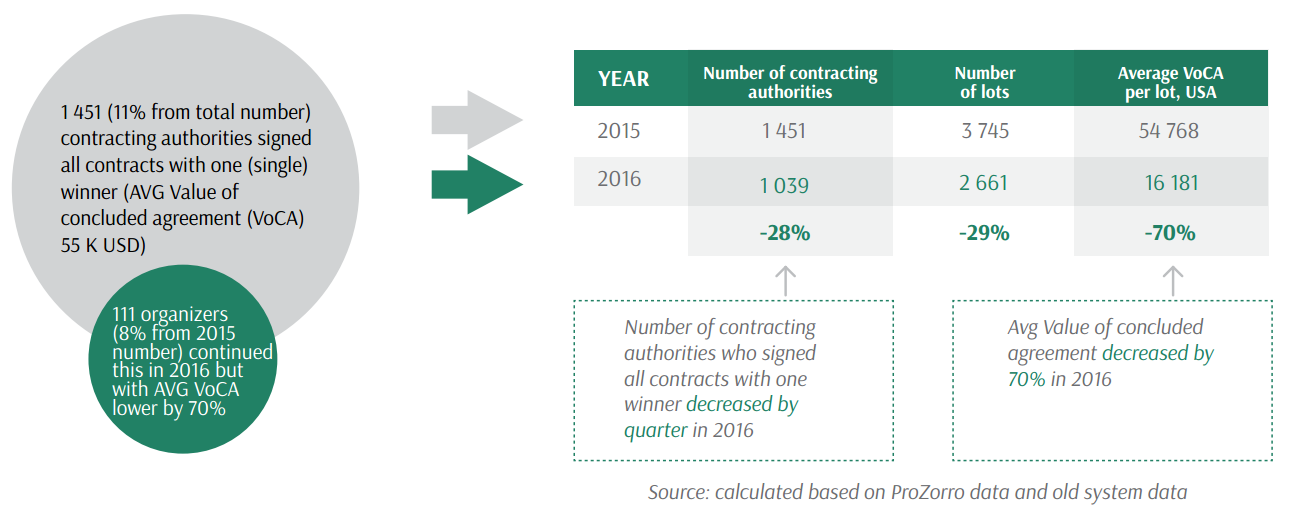Worldwide, government procurement accounts for between 8% and 21% of the GDP: government procurement is a powerful tool for influencing the market in terms of production as well as consumption. Effective functioning of this sector is a prerequisite for the formation of a stable and effective economic system in general. The full version of the report can be found here.
Here is a brief account of the development history of Ukraine’s government/public procurement system:
1994: First statutes and rules regulating government procurement. These were developed while negotiations about joining the WTO were underway.
2000: The statutes and rules were combined into a law (Law No. 1490-III of February 22, 2000). No longer valid since 2008.
2010: Law of Ukraine “On Government Procurement” (Law No. 2289-VI of June 1, 2010)
2014: The Parliament passed a new Law “On Government Procurement” (Law No. 1197-VII of April 10, 2014)
2015, February: pilot version of the ProZorro electronic system.
2015, December: Approval of the Law of Ukraine “On Public Procurement”.
2016, April: First stage of transition to the ProZorro e-system (central bodies of state administration and natural state monopolies).
2016, August: Second stage of transition to the ProZorro e-system (all other contracting authorities, as specified by the Law).
Research period: Public procurement in accordance with the previous and new (ProZorro) system in 2015-2016.
The reform of public procurement in Ukraine began in February 2015 with a pilot project; subsequently, it acquired legal status in two stages (from April 1 and from August 1, 2016) through the enactment of the Law of Ukraine “On Public Procurement” which necessitates the use of the ProZorro electronic procurement system. As of the beginning of 2017, the system covers the purchasing process of eight types of purchase described in the Law, which requires that all purchases more than 50,000 UAH be shown, and in the order SE“Zovnishtorhvydav Ukraine” – currentlyState Enterprise “ProZorro.” The electronic system connects the main portal to a network of private marketplaces. Data obtained in the process of interaction with the system are generally available and can be used for monitoring purposes.
However, adoption of the law and transition to ProZorro are not the only results of the reform.
Graph 1. Share of government procurement in the GDP, by countries

Source: OECD statistics (2013) and authors’ calculations (2013)
Infrastructural and institutional changes
- The reform made the public procurement sphere more noticeable for the wider audience; the system’s openness raised awareness of the procurement sphere and provided for greater accessibility of procurement results.
- The reform brought together all contracting authorities, bidders and the Complaints Review Board of the Antimonopoly Committee within a unified electronic system covering all types of procedures and all stages outlined by the Law “On Public Procurement.” Unlike EU countries’ systems, the Ukrainian electronic system incorporates all stages of the procurement procedure in a single framework. This makes monitoring easier and reduces purchase-related administrative cost.
- Ukraine, as a member of the WTO Agreement on Government Procurement (GPA, signed on May 18, 2016), became even more open to foreign bidders and obtained access to procurement abroad.
- The electronic system simplified access to bidding for bidders, in particular for small and medium-sized enterprises, reduced expenses of the State related to administering the system as well as the administrative expenses incurred by contracting authorities and bidders, and accelerated the procurement process in general.
- The monitoring of the procurement process covered by the electronic system (the public and professional analytical module based on QlikView) became easier and more accessible.
- Within the framework of the reform, the marketplaces were decentralized: as of the end of March 2017, fifteen accredited private marketplaces were operating (for all purchases) instead of one state-run marketplace. Commercialization of this segment increased the competition among the platforms and, according to the system authors’ expectations, will ensure ongoing improvement of the services.
- Use of the open data standard during the procurement process ensured accessibility of information, thus positively influencing the level of perception of the authorities’ transparency. Data accessibility decreases information asymmetry and provides equal opportunities for participation in public tenders.
- The reform also activate changes in spheres related to public procurement (beginning of development of the regulations on procurement monitoring, introduction of state electronic services based on the Law of Ukraine “On Amending Certain Laws of Ukraine on Access to Public Information in Open Data Form,” etc.), establishment of transparent mechanisms for state property selling through the “ProZorro. Sales” system).
Quantitative changes
- Compared to 2015, in 2016 the total volume of government procurement, calculated as the total value of the concluded agreements, increased by 35%, to 263.350 billion UAH, or by 17% in dollar terms, reaching 10.4 billion US dollars (the percentage comparison was based on amount in dollars, so as to rule out the impact of the exchange rate change). Primarily the increase was due to below-threshold purchases (purchases more than 50,000 UAH were required to be shown in the system) – there was a more than fourfold increase in the number of agreements.
Graph 2. Comparison of the volume and number of concluded agreements

- The open and simplified access to the system increased the number of bidders and suppliers: the number of unique suppliers rose three times (to 33,700), resulting in a decrease in the number of agreements per supplier and thus diminishing his mono
- The open and simplified access to the system increased the number of bidders and suppliers: the number of unique suppliers rose three times (to 33,700), resulting in a decrease in the number of agreements per supplier and thus diminishing his monopolistic power and weakening the connection with the contracting authority.
- In the suppliers’ structure, there was a substantial increase of the share of FOPs (from 24% to 42%). The number of contracting authorities increased by 53%, to 20,000. This is partially related to the necessity for displaying below-threshold purchases and to the introduction of the electronic system.
- Politic power and weakening the connectionwith the contracting authority.
- In the suppliers’ structure, there was a substantial increase of the share of FOPs (from 24% to 42%). The number of contracting authorities increased by 53%, to 20,000. This is partially related to the necessity for displaying below-threshold purchases and to the introduction of the electronic system.
Graph 3. Comparison of the structure and number of suppliers

Source: calculated based on Prozorro data and old system data
- According to hypothesis open data bring down the likelihood of conspiracy and fraud (due to public control and intense competition), which is bound to decrease suppliers’ monopolistic power. Based on the performed analysis, there was a decrease in the incentive to procure everything from single supplier: in 2016 the number of contracting authorities concluding agreements with single supplier (for all purchases made in the course of the year) drop down to 5% from 11% in 2015 and the average contract amount of such purchases decreased by 70%.
Graph 4. Comparison of the number of contracting authorities concluding agreements with one supplier

The mentioned above allows us to conclude that positive changes have been taking place. The reform increased awareness, simplified and accelerated both the procurement process and its monitoring, brought all participants together within the framework of a single system, and provided access to out-of-country purchases (GPA). The public procurement market increased in terms of volume as well as of the number of purchases made; there was also a increase in the number of participants (contracting authorities and suppliers).
At the same time, however, there are a lot of problems and issues that still need to be addressed: use of non-price evaluation criteria (at present, most purchases are made on the bases of the price criterion alone and the concluded agreements are of the fixed price type), use of financial instruments (options, futures, swaps, weather derivatives for long-term contracts or in volatile markets), evaluation and prevention of market and non-market risks (which distort the results of purchases because of conclusion of amendments to the contract), further integration with available sources of open data (for simplified evaluation of contractors), etc. Since the Ministry of Economic Development and Trade, the SE ProZorro, Transparency International Ukraine, and the Kyiv School of Economics have made up a large team to work on improving the current system and to raise the competence of all participants in the procurement process, we are hoping for the best and for new changes to the next anniversary of ProZorro.
The team of the Center for Excellence in Procurement of the Kyiv School of Economics expresses its gratitude to Viktor Khanzhyn for his critical review and to Lilia Lakhtionova for checking the correctness of the methodological part of the report.
Created as part of the project “Transparency and accountability in public administration and services” financed by USAID and UKAID

Main photo: bloomua/depositphotos
Attention
The authors do not work for, consult to, own shares in or receive funding from any company or organization that would benefit from this article, and have no relevant affiliations


